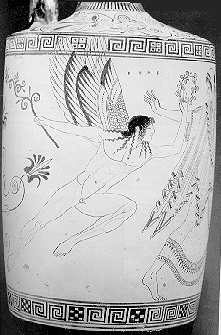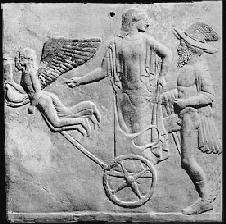| "The Boston Throne is....a sepulcral relief dating from the Imperial Age" F.I. Bastet, 1965. |
| The theory that the Boston Throne is a work from the 1st century BC stems from the fact that many workshops in Rome at this time were assimilating Greek Art. The tools used in the production of the Throne have been linked to those commonly in use at this period. However, one of the main reasons for the suggestion that the Boston Throne is a Roman work is that its representation of Eros is more akin to that of Roman art than Greek. (This is, of course, presuming that the winged youth is Eros.)
|
 |
In ancient Greek Art, Eros first appears as a winged adolescent on Attic red figure vases towards the end of the 6th Century BC. Vases contemporary to the Ludovisi Throne show Eros as as young man. The vase on the left, an Attic white ground lekythos by Douris, dates from around 500 BC, just slightly before the suggested date of manufacture of the Ludovisi Throne. Eros is clearly shown as fully grown young man. It is not until the end of the great period of Greek art, 323 BC, and in Hellenistic times, that Eros appears as the pudgy baby adopted by the Romans. The Sculpture on the right is a Hellenistic bronze, dating from around 100 BC. Eros is depicted as a young boy. |
 |
| It has been noted that the winged youth on the Boston Throne is more like Eros as perceived in the Hellenistic and Roman Classical periods than Eros in Greek art contemporary to that of the Ludovisi Throne. The winged youth on the Boston Throne, below, can be seen to be very like the Hellenistic bronze, above right. However, the terracotta reliefs from 450 BC found in the sanctuary of Persephone at Locri, show Eros as a young winged boy. In the relief from Locri, below right, Eros, and a female (possibly Psyche) can be seen pulling a chariot containing a female (possibly Aphrodite or Persephone) in the presence of Hermes. It is up to the viewer to decide if the winged youth on the Boston Throne relates to Roman or Locrian art. However, the stylistic and thematic links between The Ludovisi Throne and Locri would encourage the viewer to relate the Locrian Reliefs to the Boston Throne. The Boston Throne may also be from Locri at this period. |
 |  |